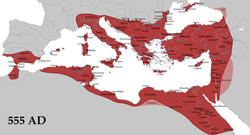Byzantine Empire
Byzantine Empire | |||||||||
|---|---|---|---|---|---|---|---|---|---|
| c. 330 – 1204 1261 – 1453 | |||||||||
 The Empire at its greatest extent in 555 AD unner Justinian the Great | |||||||||
| Status | Empire | ||||||||
| Caipital | Constantinople | ||||||||
| Common leids | |||||||||
| Releegion | Roman paganism till 380. Christianity (toleratit efter the Edict o Milan in 313; state releegion efter 380); Orthodox Christianity efter 1054. | ||||||||
| Govrenment | Absolutist autocracy | ||||||||
| Emperor | |||||||||
• 330–337 | Constantine I | ||||||||
• 1449–1453 | Constantine XI | ||||||||
| Historical era | Late Antiquity–Late Middle Ages | ||||||||
| 285 | |||||||||
| 330 | |||||||||
• Daith o Theodosius I | 395 | ||||||||
• Nominal end o Wastren Empire | 476 | ||||||||
| 1204 | |||||||||
• Reconquest o Constantinople | 1261 | ||||||||
| 29 Mey 1453 | |||||||||
• Faw o Trebizond | 15 August 1461 | ||||||||
| Population | |||||||||
• 565 AD | 26,000,000a | ||||||||
• 780 AD | 7,000,000 | ||||||||
• 1025 AD | 12,000,000 | ||||||||
• 1143 AD | 10,000,000 | ||||||||
• 1282 AD | 5,000,000 | ||||||||
| Currency | Solidus, Hyperpyron | ||||||||
| |||||||||
| |||||||||
The Byzantine Empire, an aa referred tae as the Eastren Roman Empire, wis the conteenuation o the Roman Empire in the East in Late Antiquity an the Middle Ages, whan its caipital ceety wis Constantinople (modren-day Istanbul, that haed been foondit as Byzantium). It survived the fragmentation an faw of the Wastren Roman Empire in the 5t century AD an conteena'd tae exist for an addeetional thoosand years till it fell tae the Ottoman Turks in 1453.[1] In maist o its existence, the empire wis the maist pouerfu economic, cultural, an militar force in Europe. Baith "Byzantine Empire" an "Eastren Roman Empire" are historiografical terms creatit efter the end o the realm; its ceetizens conteena'd tae refer tae thair empire as the Roman Empire (Greek: Βασιλεία τῶν Ῥωμαίων, tr. Basileia tôn Rhōmaiōn; Laitin: Imperium Romanum),[2] or Romania (Ῥωμανία), an tae themsels as "Romans".[3]
Several seegnal events frae the 4t tae 6t centuries merk the period o transeetion in that the Roman Empire's Greek East an Laitin Wast dividit. Constantine I (r. 324–337) reorganised the empire, made Constantinople the new caipital, an legalised Christianity. Unner Theodosius I (r. 379–395), Christianity acame the Empire's offeecial state releegion an ither releegious practices war proscrived. Feenally, unner the ring o Heraclius (r. 610–641), the Empire's militar an admeenistration war restructurt an adoptit Greek for offeecial uise insteid o Laitin.[4] Sicweys, awtho the Roman state conteena'd an Roman state tradeetions war mainteened, modren historians distinguish Byzantium frae auncient Roum insaefaur as it wis centred on Constantinople, orientit taewart Greek raither than Laitin cultur, an chairacterised bi Orthodox Christianity.[3]
The mairches o the Empire evolved seegneeficantly ower its existence, as it went throu several cycles o decline an recovery. In the ring o Justinian I (r. 527–565), the Empire reakit its greatest extent efter reconquerin muckle o the historically Roman wastren Mediterranean coast, includin North Africae, Italy, an Roum itsel, that it held for twa mair centuries. In the ring o Maurice (r. 582–602), the Empire's eastren frontier wis expandit an the north stabilised. Houiver, his assassination caused the Byzantine–Sasanian War o 602–628, that exowstit the Empire's resoorces an contreebutit tae major territorial losses during the Muslim conquests o the seivent century. In a matter o years the Empire lost its richest provinces, Egyp an Sirie, tae the Arabs.[5]
In the Macedonian dynasty (10t–11t centuries), the Empire again expandit an experienced the twa-century lang Macedonian Renaissance, that cam tae an end wi the loss o muckle o Asie Minor tae the Seljuk Turks efter the Battle o Manzikert in 1071. This battle appened the wey for the Turks tae settle in Anatolie.
The Empire recovered again in the Komnenian restoration, sic that bi the 12t century Constantinople wis the lairgest an walthiest European ceety.[6] Houiver, it wis delivered a mortal blaw during the Fowert Crusade, whan Constantinople wis sacked in 1204 an the territories that the Empire umwhile govrened war dividit intae competin Byzantine Greek an Laitin realms. Despite the eventual recovery o Constantinople in 1261, the Byzantine Empire remeened anerly ane o several smaw rival states in the aurie for the feenal twa centuries o its existence. Its remeenin territories war progressively annexed bi the Ottomans ower the 15t century. The Faw o Constantinople tae the Ottoman Empire in 1453 feenally endit the Byzantine Empire.[7]
References[eedit | eedit soorce]
- ↑ "Byzantine Empire". Encyclopædia Britannica.
- ↑ Kazhdan & Epstein 1985, p. 1.
- ↑ a b Millar 2006, pp. 2, 15; James 2010, p. 5; Freeman 1999, pp. 431, 435–437, 459–462; Baynes & Moss 1948, p. xx; Ostrogorsky 1969, p. 27; Kaldellis 2007, pp. 2–3; Kazhdan & Constable 1982, p. 12; Norwich 1998, p. 383.
- ↑ Ostrogorsky 1969, pp. 105–107, 109; Norwich 1998, p. 97; Haywood 2001, pp. 2.17, 3.06, 3.15.
- ↑ Warfare, State And Society In The Byzantine World 560–1204. p. 47.
- ↑ Pounds, Norman John Greville. An Historical Geography of Europe, 1500–1840, p. 124. CUP Archive, 1979. ISBN 0-521-22379-2.
- ↑ "The End of the Byzantine Empire, 1081–1453". Archived frae the original on 13 Mey 2016. Retrieved 16 Julie 2017.
- Airticles conteenin Ancient Greek (to 1453)-leid text
- Byzantine Empire
- Umwhile kintras in Europe
- Umwhile kintras in Asie
- Umwhile kintras in Africae
- States an territories established in 330
- 1453 disestablishments
- States in medieval Anatolie
- Roman Empire
- History o the Mediterranean
- History o Wastren Asie
- History o Europe
- Soothren Europe
- Eastren Europe

